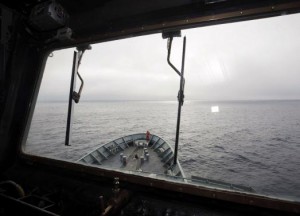
(Reuters) – Australian authorities said on Friday they were shifting the focus of their Indian Ocean search for the wreckage of Malaysia’s missing jet, moving it 1,100 km (685 miles) to the northeast after receiving new information from Malaysia.
For more than a week, ships and surveillance planes have been scouring seas 2,500 km (1,550 miles) southwest of Perth, where satellite images had suggested there could be debris from Malaysia Airlines Flight MH370, which went missing on March 8 with 239 people aboard.
The dramatic shift in the search area was based on analysis of radar data between the South China Sea and the Strait of Malacca, the Australian Maritime Safety Authority (AMSA) said. At that time, the Boeing 777 was making a radical diversion west from its course from Kuala Lumpur to Beijing.
The data indicated the plane was travelling faster than previously estimated, meaning it was burning fuel faster and reducing the distance it might have traveled south into the Indian Ocean, AMSA said in a statement.
“As a result today’s search will shift to an area 1,100 km to the northeast based on updated advice provided by the international investigation team in Malaysia,” it said.
Satellite images had shown suspected debris, including pieces as large as 24 meters (70 feet), within the original search area in the southern Indian Ocean.
An AMSA spokeswoman said she had no further information on what the debris seen in satellite images might have been or if it was related to the missing plane.
Potential debris has also been seen from search aircraft but none has been picked up or confirmed as the wreckage of Flight MH370, which disappeared from civilian radar screens less than an hour after taking off.
Officials believe someone on board may have shut off the plane’s communications systems before flying it thousands of miles off course where it crashed into the ocean in one of the most isolated and foreboding regions on the planet.
Theories range from a hijacking to sabotage or a possible suicide by one of the pilots, but investigators have not ruled out technical problems.
SHIFTING SEARCHES
Ten international aircraft and six ships were now being directed to the new area of 319,000 square kilometers and around 1,850 km (1,150 miles) west of Perth. The Australian Geospatial-Intelligence Organisation was also redirecting satellites there, AMSA said.
The latest twist underscores the perplexing and frustrating hunt for evidence in the near three-week search. It comes less than a day after sightings of possible wreckage captured by Thai and Japanese satellites in roughly the same frigid expanse of sea as earlier images reported by France, Australia and China.
“We detected floating objects, perhaps more than 300,” Anond Snidvongs, the head of Thailand’s space technology development agency, told Reuters on Thursday. “We have never said that the pieces are part of MH370 but have so far identified them only as floating objects.”
The U.S. Navy said on Friday it was sending a second P8 Poseidon maritime surveillance aircraft to help in the search.
“It’s critical to continue searching for debris so we can reverse-forecast the wind, current and sea state since March 8th to recreate the position where MH370 possibly went into the water,” said Commander Tom Moneymaker, a U.S. 7th Fleet oceanographer.
The United States has also sent a device that can be towed behind a ship to pick up faint pings from the plane’s black box voice and data recorders, but time is running out.
“We’ve got to get this initial position right prior to deploying the Towed Pinger Locator since the MH370’s black box has a limited battery life and we can’t afford to lose time searching in the wrong area,” Moneymaker said.
The prolonged and so far fruitless search and investigation have taken a toll, with dozens of distraught relatives of 150 Chinese passengers clashing with police and accusing Malaysia of “delays and deception”.
Chinese insurance companies have started paying compensation to the families of passengers, some of the firms and state media said.







